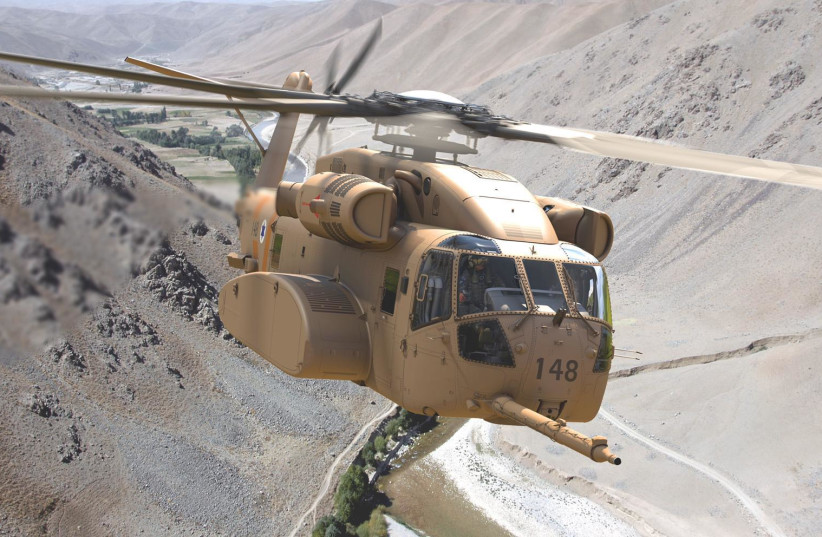 US uses helicopter raid to kill ISIS operative in Syria -analysis
US uses helicopter raid to kill ISIS operative in Syria -analysis
SETH J. FRANTZMAN
The target of the US helicopter raid was Rakkan Wahid al-Shammri, an ISIS official involved in smuggling weapons to other ISIS units.
.

A rare US raid in the afternoon of October 6 killed an ISIS member in Syria, a day prior US Central Command sent forces via helicopter to raid a village near Qamishli.
The target of the US helicopter raid was Rakkan Wahid al-Shammri, an ISIS official involved in smuggling weapons to other ISIS units, according to the US. ISIS was mostly defeated in Syria in 2017, but elements held out until 2019 when it was vanquished near the Euphrates river.
The raid killed one and wounded another ISIS member, and two others were detained. The next day US Central Command put out a statement saying that US forces conducted a successful airstrike in northern Syria, killing both Abu Hashum al-Umawi, an ISIS member, and another senior ISIS official.
The Syrian Observatory for Human Rights (SOHR) on Thursday told Kurdish media Rudaw that the “person killed had been a resident of the village, and according to their local sources, was likely to be affiliated to the Islamic State (ISIS)….US forces carried out an airdrop operation after midnight on Wednesday-Thursday, within the areas of influence of the Syrian regime for the first time.”
Qamishli, a town on the Turkish border in northeast Syria, whose residents are Kurds, Christians and others and has been an important center of resistance against ISIS.
However, the complex overlapping ruling groups in the area, including the Syrian regime and Syrian Democratic Forces mean that ISIS can still operate in the area of the town.
Other ISIS cells popped up in Turkish-controlled areas in northwest Syria, where ISIS leader Abu Bakr al-Baghdadi and other ISIS officials have been found over the years, several of which were killed by US forces.
The Syrian regime has controlled an area of Qamishli throughout the war in Syria, however, it expanded its role in 2019 when Turkey conducted an invasion of part of northern Syria. Turkish-backed Syrian rebels and extremist groups attacked Kurdish forces and Christians in Tel Tamr.
Al-Hol camp
In recent months the spotlight in eastern Syria has moved to concentrate on the Al-Hol camp, a large camp for displaced people where some ISIS families ended up in 2019. The camp is so large that the SDF has had trouble dealing with the continuing ISIS problem inside the camp.
That means that ISIS members, primarily women who were wives of ISIS fighters, can run parts of the camp and continue to abuse other women and children.
This includes some Yazidis, members of a minority group ISIS committed genocide against in 2014. Some Yazidi women and children, kidnapped by ISIS, were found in the camp. Pro-ISIS supporters abroad also continue to try to send money to ISIS members in the camp and there are attempts at breakouts.
According to NBC “the Biden administration has enacted a new plan to reduce the population of a sprawling refugee camp near the Iraq-Syria border that has become a haven for the Islamic State terrorist group to recruit members, plot a comeback and carry out some of its most brutal tactics — including the torture and sexual abuse of women and girls — according to five senior administration officials.”
“the Biden administration has enacted a new plan to reduce the population of a sprawling refugee camp near the Iraq-Syria border that has become a haven for the Islamic State terrorist group to recruit members, plot a comeback and carry out some of its most brutal tactics — including the torture and sexual abuse of women and girls — according to five senior administration officials.”
NBC
The tens of thousands of people in the camp generally can’t be processed to go anywhere else because no country wants to claim responsibility for them.
The NBC report says “six European countries and Australia have so far agreed to transport dozens of their citizens being held at the camp back to their homelands in the coming weeks, those officials said.”
The problem is that countries that support the US-led Coalition to fight ISIS tend to not want their citizens back, even stripping them of citizenship in some cases, leaving the people in legal limbo.
These countries also won’t allow the SDF to put the ISIS members on trial, arguing that the SDF is not the governing force in Syria.
The western governments also don’t want the SDF turning the ISIS members over to the Syrian regime, because it abuses human rights. And they don’t want the SDF to let the people go or send them to Iraq.
This means the SDF must continue to secure the camp, but the international community won’t help the SDF do more than that; such as de-radicalize the people in the camp or sending in child protective services to help the kids.
The continuing presence of ISIS in Syria is clear. It is also clear that ISIS members often operate from areas close to the Turkish border, either in Idlib or in Afrin, an area Turkey invaded in 2018 and ethnically cleansed of Kurds. Turkey has threatened to attack on the SDF over the years, meaning eastern Syria continues to face the prospect of instability.
Zawartość publikowanych artykułów i materiałów nie reprezentuje poglądów ani opinii Reunion’68,
ani też webmastera Blogu Reunion’68, chyba ze jest to wyraźnie zaznaczone.
Twoje uwagi, linki, własne artykuły lub wiadomości prześlij na adres:
webmaster@reunion68.com
